Books written or edited by Nick Wates. In date order, most recent first.
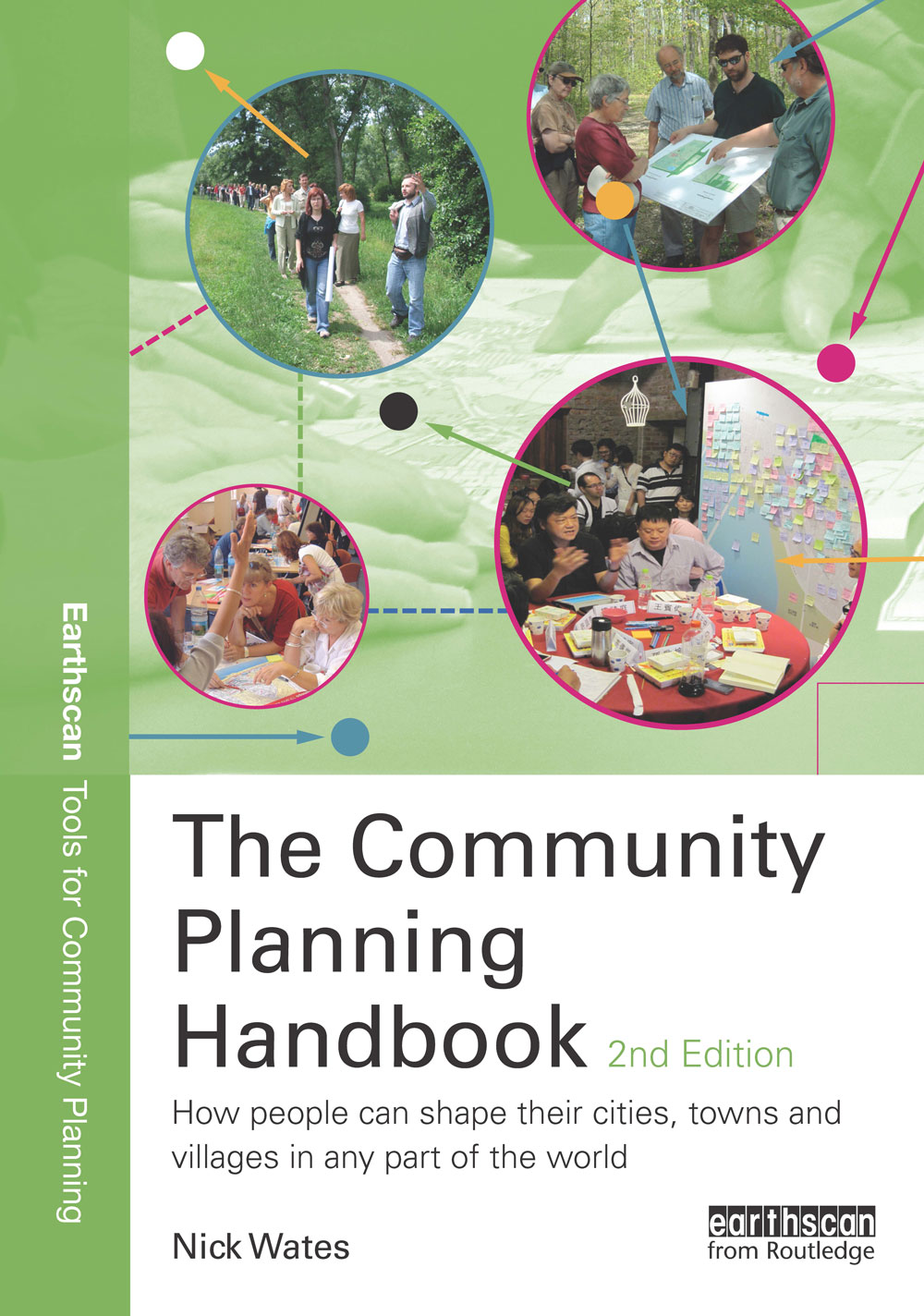
The Community Planning Handbook
How people can shape their cities, town and villages in any part of the world.
The first comprehensive worldwide how-to-do-it published on public involvement in planning and design. It features an accessible style, best practice information on effective methods, international scope and relevance and full colour throughout. A vital reference for practitioners, policy makers and students throughout the world.
Order from Routledge, from Amazon, obtain through reputable bookshops or buy from the NWA Shop on this website. See Routledge publicity flyer with 20% discount code.
Further Information
Growing numbers of residents are getting involved with professionals in shaping their local environment, and there is now a powerful menu of tools available, from design workshops to electronic maps. The Community Planning Handbook is the essential starting point for all those involved – planners authorities, architects and other practitioners, community workers, students and local residents.
It features an accessible how-to-do-it style, best practice information on effective methods, and international scope and relevance. Tips, checklists and sample documents help readers to get started quickly, learn from others’ experience and to select the approach best suited to their situation. The glossary, bibliography and contact details provide quick access to further information and support.

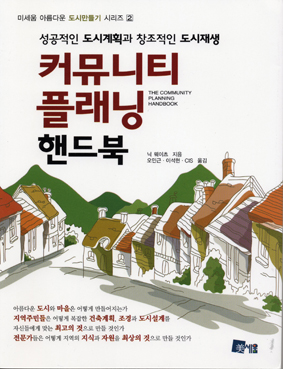
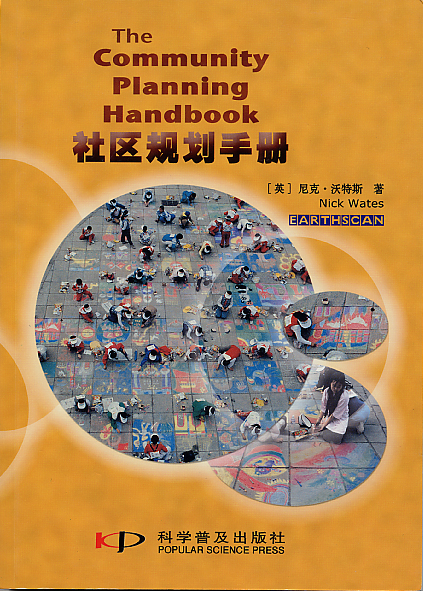
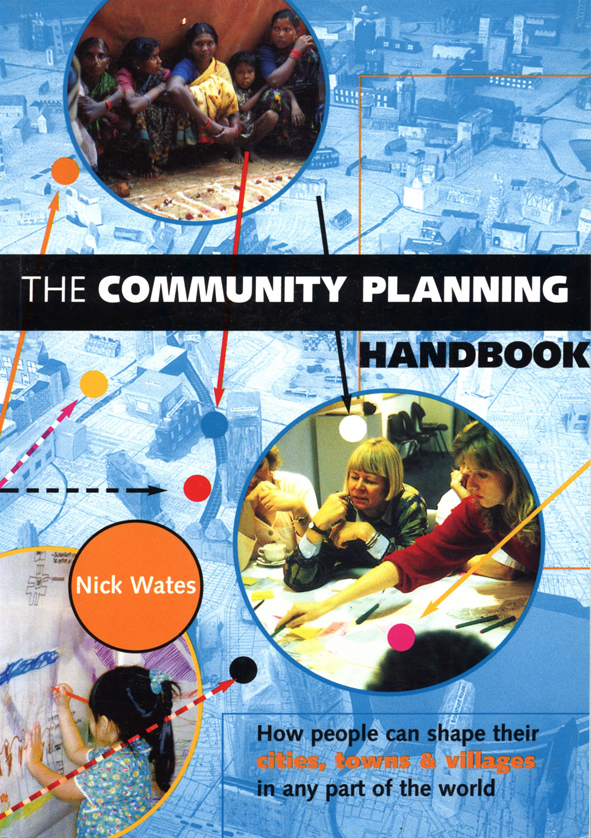
“A clear, well organized and extremely useful book for those who are or who ought to be promoting democratic participation in shaping the future of our communities.”
J Gary Lawrence, President, Sustainable Strategies & Solutions, Inc, Seattle, Washington, USA
“In the global, cyberspace age, government and business need communities as much as communities need them. Nick Wates’ timely book is essential reading for ordinary people and professionals who believe that the opportunities being thrown up by this new balance are there for the taking”
Mark Hepworth, Director, The Local Futures Group, London, UK
“This excellent work shows an absolute understanding of the issues of consultation and participation. Many dabble without this understanding.”
Peter Richards, Deicke Richards Architects, Australia.
“This is the best practical guide to running a community planning event, and a must for community groups and councils both in the UK and abroad”
Roger Evans, Chairman, Urban Design Group, UK
“The layout brings a new standard of design excellence to the art of communication in this field. I highly recommend it as a practical tool for communities and their activists. It has a truly international perspective.”
Michael Parkes, Expert on Urban Policy to the European Commission, Directorate General Development, Brussels, Belgium
“The clear and concise copy as well as the very appealing graphic formatting of the material make this an excellent handbook which will be useful to so many different users in so many ways.”
Tony Costello, Professor of Architecture, Ball State University, USA
“An invaluable guide in helping you choose and plan the participatory events and structures to meet your needs.”
John Thompson, architect and community planner
“A graphically pleasing publication in simple language that will get across effectively to communities.”
Vinay D. Lall, Director, Society for Development Studies, New Delhi, India
“An excellent book that will have a host of valuable applications – with sufficient detail for practitioners, researchers, planners and policy makers. It is an important and timely contribution.”
Jules Pretty, Director, Centre for Environment and Society, University of Essex
The Community Planning Handbook
How people can shape their cities, town and villages in any part of the world.
Compiled and edited by
Nick Wates
Designed by
Jeremy Brook, Graphic Ideas
First edition Earthscan Publications Ltd, 2000
ISBN 1-85383-654-0
Chinese translation by Earthscan China Project, 2002. Translator Lu Jianbo.
ISBN 7-110-05378-4
Chinese edition
Korean translation by Misewoom Publishing Co., 2008
ISBN 978-89-85493-28-4
Korean edition
Second edition Routledge, Taylor & Francis, 2014
ISBN 978-1-84407-490-7
Published in association with:
The Urban Design Group; The Prince’s Foundation; South Bank University, London. With the generous support of: Department of the Environment, Transport and the Regions, England; Department for International Development, UK; European Commission Humanitarian Office; John Thompson & Partners; Urban Regeneration Office, Taipei City and The Urbanists Collaborative, Taipei.
296 pages, 210x148mm, 250 photos and illustrations, full colour throughout. The book covers 58 general principles, 61 methods and 24 scenarios. The appendices include a glossary with over 600 entries, an annotated publications listing with 89 entries and 180 useful contacts and web links. (First edition: 230 pages, 230 photos and illustrations, 47 principles, 53 methods, 16 scenarios, 500 entry glossary.)
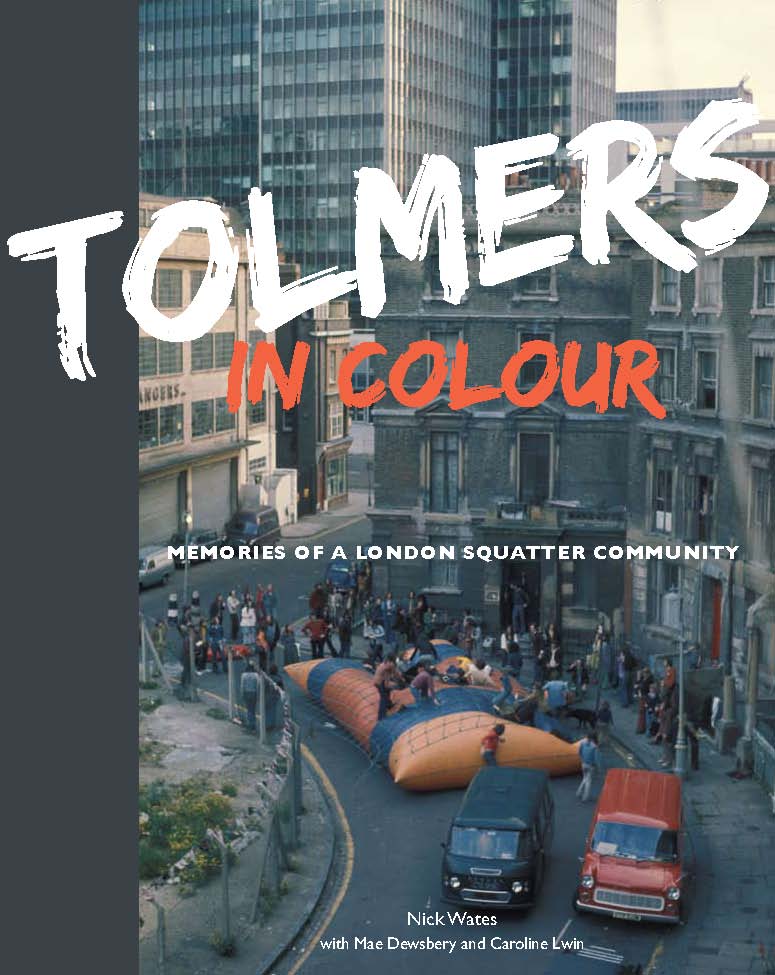
Tolmers in Colour
Memories of a London squatters community
Between 1973 and 1979, a few streets in Central London became the heart of a squatting community fighting to safeguard the area’s future while exploring new ways of living. In Tolmers in Colour, Nick Wates, one of the leading campaigners, shares some personal and political memories from his photo archive.
Order from Amazon or buy directly from the NWA Shop on this site.
Further Information
Between 1973 and 1979, a few streets in Central London became the heart of a squatting community fighting to safeguard the area’s future while exploring new ways of living. See the Tolmers Gateway for further information.
In Tolmers in Colour, Nick Wates, one of the leading campaigners, shares some personal and political memories from his photo archive.
As a result of the campaigns recorded in this book, the Georgian streets surrounding Tolmers Square – home to a thriving Asian community – were spared from the bulldozer, less office space than at first proposed was constructed and the area of new development became one of the first schemes in recent years to integrate housing, workspace, shopping and leisure facilities. Sadly the original Square itself was demolished.
“A brilliant series of photos…”
Time Out, 18-24 November 2010
“‘…such a beautiful Tolmers record. The quality of the photos and their presentation in this booklet is superb. The colour in particular gives me a real physical pleasure as if I were looking at some master artist’s paintings. They certainly do make the Tolmers adventure come alive. I am particularly struck by the dancing figures and even more by the charming behaviour towards children – a natural community.’”
Giles Heron, author, farmer and historian, letter, January 2011
Tolmers in Colour
Memories of a London squatters community.
Nick Wates
with Mae Dewsbery and Caroline Lwin
ISBN 978-0-9507259-2-5
Bay Leaf Books, 2011
80 pages 25.3 x 21 x 1.5 cm, full colour throughout.
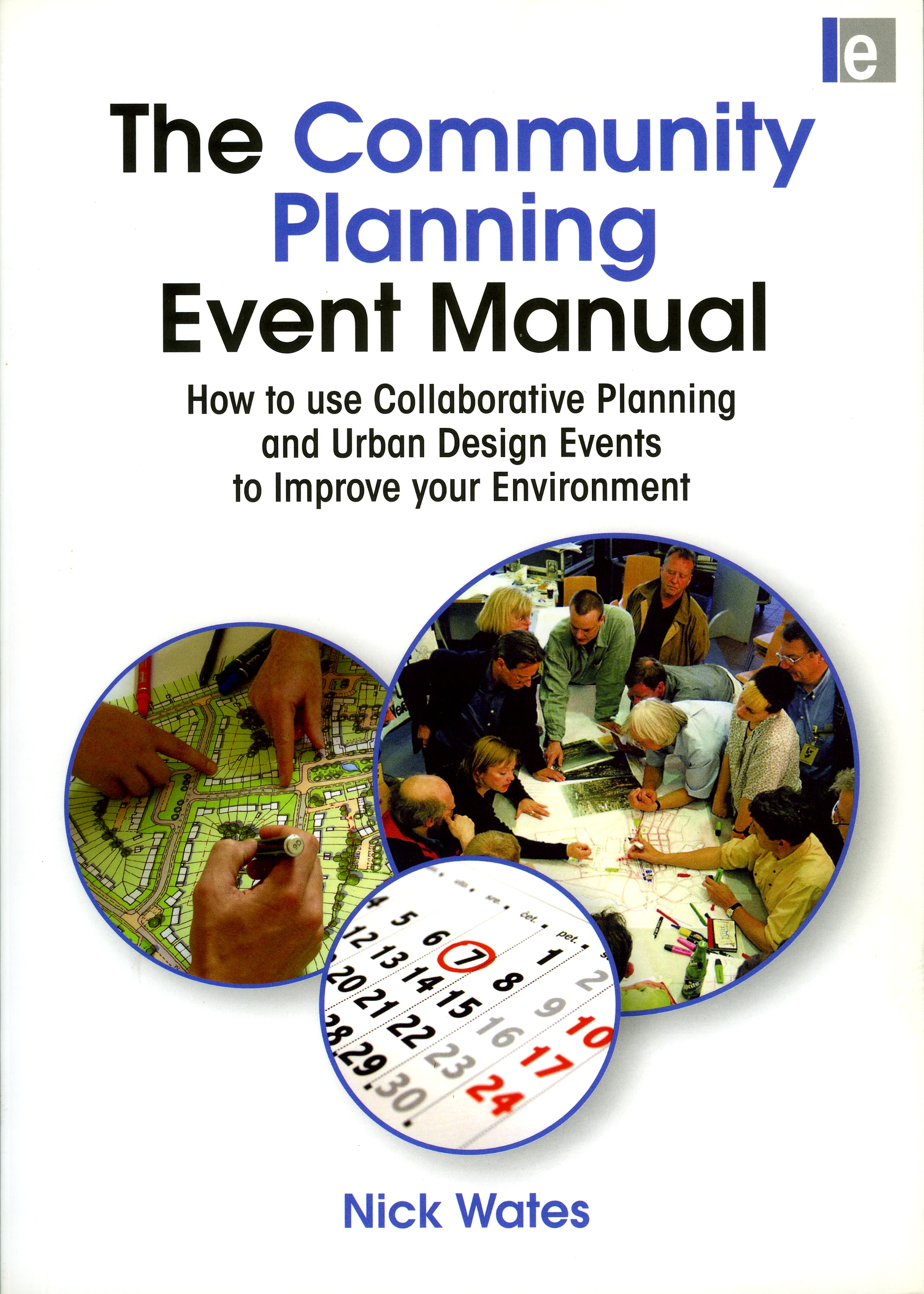
The Community Planning Event Manual
How to use Collaborative Planning and Urban Design Events to Improve your Environment.
Explains how and why to organise community planning events in any context from small neighbourhood improvements to major infrastructure and construction projects anywhere in the world. Includes a step-by-step guide, detailed checklists and other tools for event organisers.
With a Foreword by HRH The Prince of Wales and an Introduction by John Thompson.
Order from Routledge, from Amazon or obtain through reputable bookshops. Buy a digital version from the NWA Shop on this website. See Routledge publicity flyer with 20% discount code.
Further Information
All over the world people are organizing dynamic collaborative events to improve their surroundings. For a few intensive days, everyone concerned gets an opportunity to have their say and be involved – residents, businesses, professionals and politicians. It’s effective and it’s fun.
This Event Manual, the first on the subject, explains why and how to organize community planning events. The book is aimed at anyone – from concerned individuals to community groups to professional planners in business and government – interested in the remarkable potential of community planning events. It includes a step-by-step guide, detailed checklists and other tools for event organisers. The method is user-friendly, flexible and easy to employ in any context from small neighbourhood improvements to major infrastructure and construction projects anywhere in the world.
The Community Planning Event Manual is a revised and updated version of Action Planning (1996).

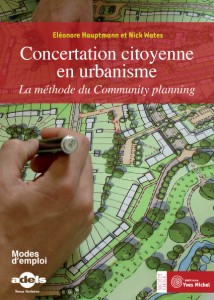
“This book helps promote practical work that changes the way people deliver projects in the sustainable communities sector. It is useful, user-friendly and easy to follow, full of case studies to illustrate ideas. This is the kind of work the busy practitioners of today need to support them in their work.”
Professor Peter Roberts, Chairman, Academy for Sustainable Communities
“Just as planning decisions should be tailored to suit the needs of the community so too should the processes that achieve those decisions. This book advocates just that in a manner that is accessible to both community groups and planning officers. The sections on financial planning, event timescale and the final chapter, Follow Up, are particularly constructive.”
Dr Katharine Martindale, Director of Cities Research Alliance
“Nick Wates is a trail blazer in communicating clear, concise and immediately useful tools and techniques that transmit energy and make you want to get stuck in. This publication is amongst a handful of documents that all urban practitioners should have to hand.”
Ian Munt, International Urban Governance Consultant
“Some books help you to learn – this one helps you to deliver! An invaluable tool for anyone involved in community planning.”
Professor Brian Evans, Deputy Chair, Architecture+Design Scotland and Partner, Gillespies llp
“The devil is as always in the detail, and Nick Wates’ Community Planning Event Manual provides it. If you want to know the effect of having carpet in your venue, or what coloured Post-its to use, this is the book for you.”
Perry Walker, Head of Democracy and Decision-making, New Economics Foundation
“… of enormous value to anyone working in the development industry: developers, public sector organisations, community groups and professional advisers. As the planning system moves more and more towards a process-driven decision-making framework, with the active participation of local people in that process, this book will become a ‘must-have’ for anyone engaged in development projects…”
Pat Willoughby, Head of Housing & Regeneration Policy, West Midlands Combined Authority
The Community Planning Event Manual
How to use Collaborative Planning and Urban Design Events to Improve your Environment.
By Nick Wates with Foreword by HRH The Prince of Wales and Introduction by John Thompson
Designed by
Jeremy Brook, Graphic Ideas
Earthscan Publications Ltd, 2008
ISBN 9781844074921 (Paperback)
ISBN 9781138177376 (Hardback)
With the generous support of
The Academy of Urbanism
English Partnerships
John Thompson & Partners
The Prince’s Foundation
128 pages, 210 x 148mm, 98 photos, 32 illustrations, full colour throughout.
French translation and adaptation:
Concertation citoyenne en urbanisme; La méthode du Community Planning
Eléonore Hauptmann & Nick Wates
Yves Michelle, 2010
www.yvesmichelle.org
ISBN: 978 2 913492 73 8
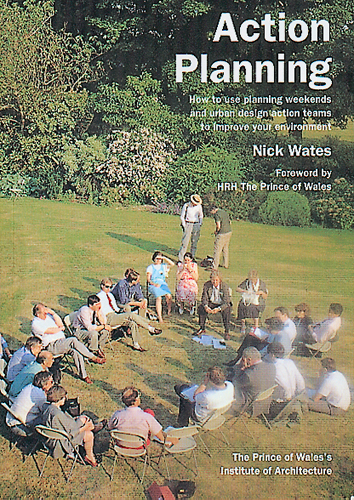
Action Planning
How to use planning weekends and urban design action teams to improve your environment.
All over the world people have started organising special collaborative events to improve their surroundings. For a few intensive days, everybody concerned gets an opportunity to have their say and get involved; residents, businesses, professionals, politicians. It’s effective and it’s fun. This book – the first on the subject – tells you how to do it.
Further Information
Want to improve your village? Your town? Your city? Frustrated with conventional planning processes? Action Planning may be just what you are looking for.
All over world people have started organising special collaborative events to improve their surroundings. For a few intensive days, everybody concerned gets an opportunity to have their say and get involved; residents, businesses, professionals, politicians. It´s effective and it´s fun.
The formula which makes this possible has become known as Action Planning. It involves skilful programming and a range of new techniques for allowing people from different walks of life to work creatively together.
This book – the first on the subject – tells you how to do it. It is aimed at anyone interested in the potential of Action Planning and includes detailed checklists for organisers.




“An extremely useful and practical guide…an invaluable source of very down-to-earth advice on this approach to community development.”
Town Planning Review, Liverpool University, April 1997
“A unique guide to the whole process of Action Planning, particularly suitable for those new to the concept and who have a desire to take action for themselves….
Clearly and attractively set out, the book is a joy to handle – the size, weight and layout all contribute to its being a truly handy reference guide which encourages you to use it. The text is simple, direct and unpretentious, and makes great effort not to get bogged down in intellectualising…. Its value has been proven in the field – most recently in Kazimierz, Krakow.”
Partnership Action, 11 June 1996
“Action Planning is marvellous. Its so good to see all those complexities so clearly sorted out and under one cover. Your sequence is brilliant….. A million congrats on a job beautifully done.”
David Lewis, American Institute of Architects. April 1996
“A very interesting format for getting the information across – I will be using it with my students at Manchester as part of the Architecture in the Community Unit.”
John Bishop, PLACE, Manchester. 11 October 1996
“Compiled with great care and thoroughness. It lists the smallest details to which attention needs to be paid in order to make Action Planning fruitful…. The text is succinct and well-illustrated…. The handbook illustrates the excitement Action Planning events generated in the USA and UK.”
Dr Meera Bapat, Open House International, No 3 1996
“Comprehensive and accessible which is crucial for communities wishing to use these tools for themselves.”
Romy Shovelton, Wikima Consulting.12 January 1996
“Your ideas bring fresh air in the bureaucratic world of planning monotony.”
Professor Santosh Ghosh, Centre for Built Environment, Calcutta, 16 September 1996
“A really useful ‘recipe’ book to help make one’s own local ‘menu’ of a community planning ‘meal’ to suit one’s own taste! I keep it on my desk all the time.”
Hilary Reed, Planning Department, Basingstoke & Deane Borough Council. 8 October 1996
Action Planning
How to use planning weekends and urban design action teams to improve your environment
Compiled and edited by Nick Wates,
The Prince of Wales’s Institute of Architecture, 1996.
ISBN 1-898465-11-8
Foreword by HRH The Prince of Wales
Published in association with the Urban Villages Forum. With the generous support of English Partnerships and Inner City Aid.
100 pages, 46 black and white photographs, 22 line illustrations, 19 checklists, 12 sample documents, 5 process diagrams.
Chinese translation by Ching-Dar Hsieh, Chuan Hsing Publishing Company, 1996.
Tel: +886 2 27752207
Fax: +886 2 27318734
e-mail: chuanshing@ms11.url.com.tw
ISBN 957 9693 27 7
German translation by Andreas von Zadow with Bettina Moser, Perspektiven – werkstatt, MATCH, 1997.
web: http://vonzadow.de
ISBN 3-88118-231-4
Czech translation by Environmental Partnership for Central Europe – Czech Republic, Program for Public Spaces, 1999. www.nadacepartnerstvi.cz
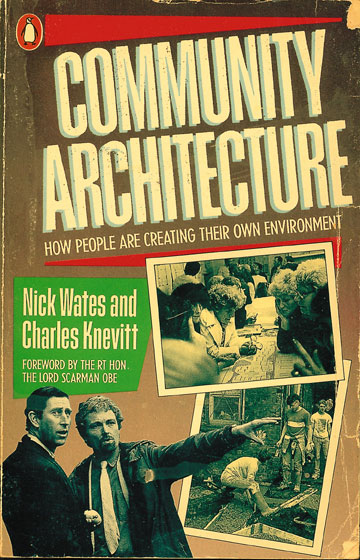
Community Architecture
How people are creating their own environment
By Nick Wates and Charles Knevitt
Community architecture has emerged as a powerful force for change in the way people all over the world are creating their own homes, neighbourhoods and cities. This book – the first on the subject – explains how and why Community Architecture works and reveals the full story of the quiet revolution which provides hope for communities everywhere.
Order from Routledge, from Amazon or through reputable bookshops. Early editions and translations from the NWA Shop on this website. See Routledge publicity flyer with 20% discount code.
Further Information
Community architecture has emerged as a powerful force for change in the way people all over the world are creating their own homes, neighbourhoods and cities.
The basic principle is simple: the built environment works better if the people who use it are directly and actively involved in its creation and management. The movement embraces planning, development, landscape, art and design as well as architecture and other forms of technical aid. It has brought together an extraordinary alliance of community groups, professionals, church leaders and politicians of all parties – and caused major ructions in the professions as a result.
Charles Knevitt and Nick Wates wrote and broadcast on the development of the Community Architecture movement for over ten years before writing this book – the first on the subject. It explains how and why Community Architecture works and reveals the full story of the quiet revolution which provides hope for communities everywhere.
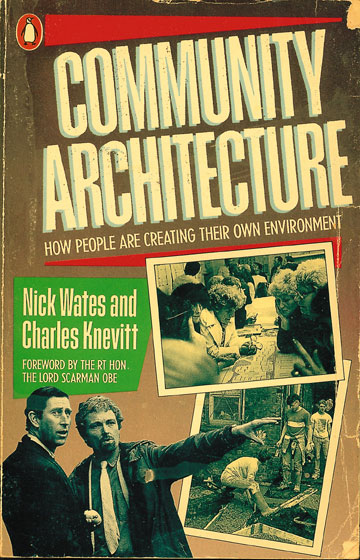
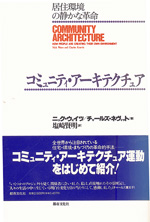
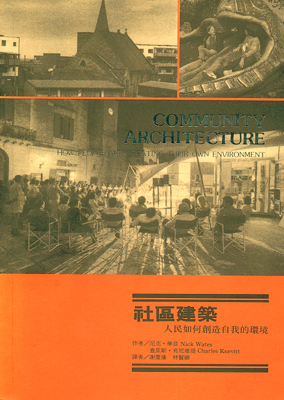
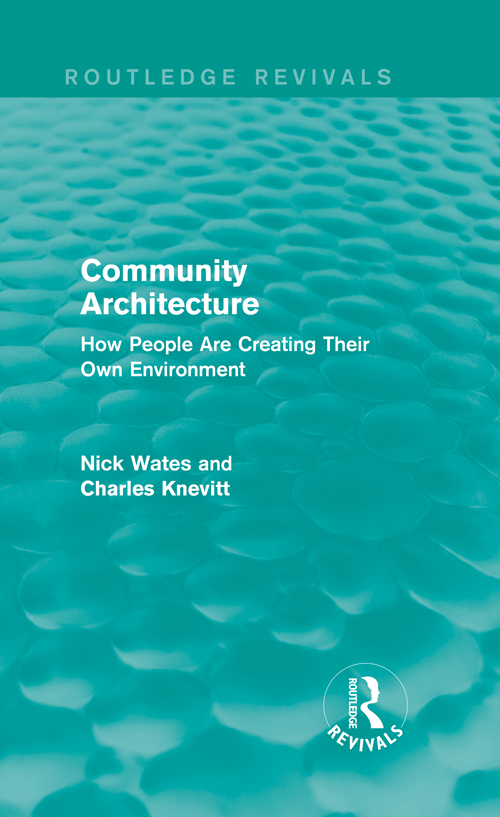
“…indispensable to all concerned with the disastrous state of our built environment. A pioneering and definitive work….”
Vivian Linacre, Environment Now, April 1988.
“…written with such tenacity of purpose that arguments for and against seem as irrelevant as King Canute attempting to push back the waves.”
Jim Antoniou, Building Design, 29 January 1988.
“…absolutely essential reading…. The book succeeds in demonstrating the many things which can be achieved by, and through, the changed relationship between designer and client which is at the heart of successful progress.”
Jeff Bishop, Bulletin of Environmental Education, November 1987.
“…an antidote to apathy… that can have the dangerous effect of not just making you sit back and ponder on the ills of the world, but of stimulating you enough to want to get stuck in to try and tackle them.”
Kelvin McDonald, Planning, 27 November1987.
“…an invaluable experience for community workers and architects dealing with urbanisation in Taiwan…. The best reference work available.”
Ruimao Huang, Lecturer at Tankang University, China Times, 18 November 1993.
“…a Bible to (Prince) Charles.”
Anthony Holden, Charles: A Biography, Weidenfeld and Nicholson, 1988
Community Architecture
How people are creating their own environment
Nick Wates and Charles Knevitt,
Penguin Books, 1987.
ISBN 0 14 010428 3
Foreword by the Rt Hon The Lord Scarman.
Sponsors include: Calouste Gulbenkian Foundation, Rod Hackney Foundation, Stanhope Securities, Wates Foundation.
Japanese translation by Dr Yoshimitsu Shiozaki, Toshi Bunka Sha, 1992.
ISBN 4 88714 120 3
Chinese translation by Ching-Dar Hsieh and Hsian-Ching Lin,
Chuan Hsing Publishing Company, 1993.
ISBN 957 9693 13 7
Reissue: Routledge Revivals, Taylor & Francis Group
Hardback, 2013: 978-0-415-70853-1
Paperback, 2014: 978-0-415-70858-6:
E-book 2014: 9781315885957
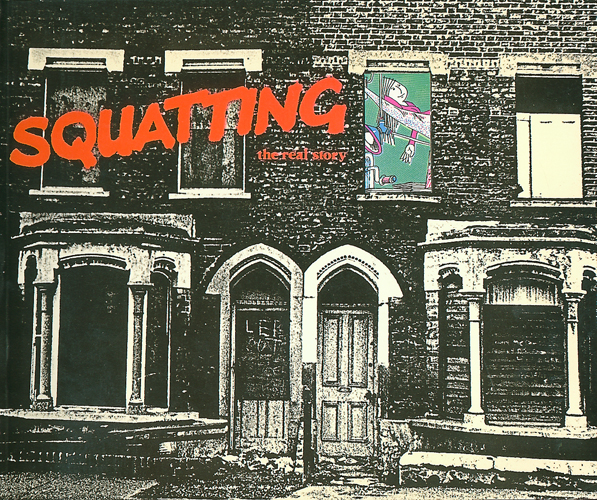
Squatting
The real story
Edited by Nick Wates and Christian Wolmar.
Squatters are usually portrayed as worthless scroungers hell-bent on disrupting society. Here is the inside story of the hundreds of thousands of people who have squatted in Britain since the war. The country is riddled with empty houses and there are thousands of homeless people. When squatters logically put the two together the result can be electrifying, amazing and occasionally disastrous.
Further Information
Squatters are usually portrayed as worthless scroungers hell-bent on disrupting society. Here is the inside story of the hundreds of thousands of people who have squatted in Britain since the war.
The country is riddled with empty houses and there are thousands of homeless people. When squatters logically put the two together the result can be electrifying, amazing and occasionally disastrous.
Squatting: the real story is a unique and diverse account of squatting. Written and produced by squatters, it covers all aspects:
- The history of squatting
- Famous squats
- The politics of squatting
- Squatting as a cultural challenge
- The facts behind the myths
- Squatting around the world
“The first well-researched, fully illustrated coffee table squatting book…a cheerful celebration of a living movement”
John Forsyth, Time Out, 6 February 1981
“…lucid, well-packaged, amusing and serious…a cornucopia of excellence.”
Undercurrents, April 1981
“…an invaluable source book…its design is a joy to look at and the illustrations are sharp and to the point.>
Rodney Mace, Morning Star, 2 January 1981
“…a really super book on one of the truly moving issues of our time…. well written and brilliantly produced.”
Gair Rhydd, 14 January 1981
“This excellent and thoroughly researched book…should be in every housing department in the land.”
Brian Lake, Architects’ Journal, 18 February 1981
“The many facets of squatting…are brilliantly evoked both in the text and the numerous well chosen illustrations…. the book is designed with great flair and imagination and has been beautifully produced.”
Nick Raynsford, Voluntary Action, Spring 1981
Squatting : the Real Story
Compiled by Nick Wates.
Edited by Nick Wates and Christian Wolmar.
Written by Nick Anning, Celia Brown, Piers Corbyn, Andrew Friend, Mark Gimson, Andrew Ingham, Pat Moan, Tom Osborn, Ann Pettitt, Steve Platt, Jill Simpson, Colin Ward, David Watkinson, Heathcote Williams and Tristan Wood.
Designed by Caroline Lwin.
Illustrated by Andy Milburn.
Published by Bay Leaf Books, 1980.
Paperback ISBN 0 9507259 1 9
Hardback ISBN 0 9507259 0 0
Sponsorship from: Calouste Gulbenkian Foundation.
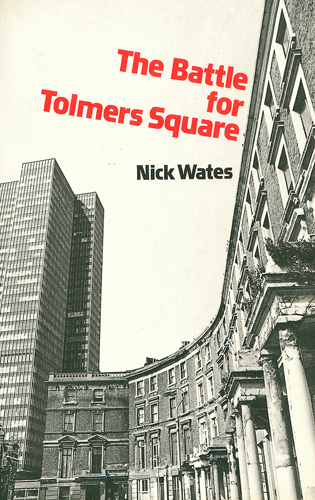
The Battle for Tolmers Square
For seventeen years, Tolmers Square in north London was the focus of a conflict involving tenant’s groups, community associations, students, squatters, intellectuals, political parties at both national and local level, and property developers. The dramatic story of that conflict is told by Nick Wates, who describes how Tolmers Square became a national symbol of the fight against property speculation and the need for community involvement in planning.
The book focuses on one case-study, but the same processes operate in all cities. By tracing the Tolmers case in detail, the book shows clearly the destructive forces which often operate in city redevelopment, and the effectiveness of various forms of campaigning and community action.
Order from Routledge, from Amazon or through reputable bookshops. Early editions from the NWA Shop on this website. See Routledge publicity flyer with 20% discount code.
Further Information
For seventeen years, Tolmers Square in north London was the focus of a conflict involving tenant’s groups, community associations, students, squatters, intellectuals, political parties at both national and local level, and property developers. The dramatic story of that conflict is told by Nick Wates, who describes how Tolmers Square became a national symbol of the fight against property speculation and the need for community involvement in planning.
The book focuses on one case-study, but the same processes operate in all cities. By tracing the Tolmers case in detail, the book shows clearly the destructive forces which often operate in city redevelopment, and the effectiveness of various forms of campaigning and community action.

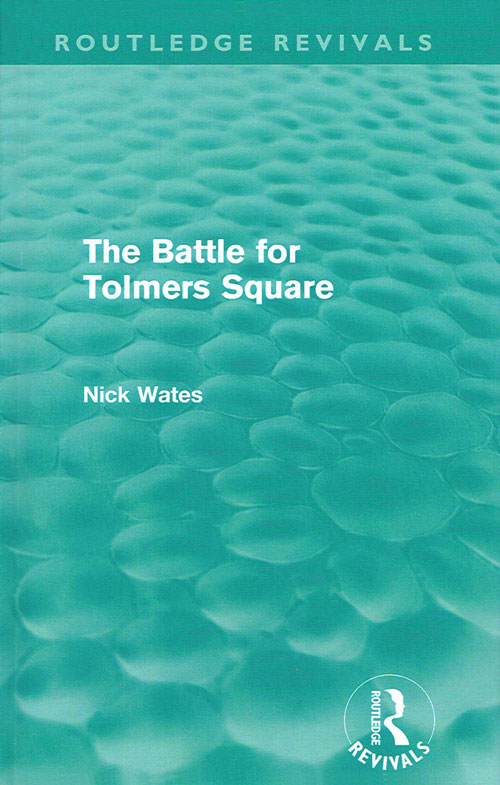
“The book is alive with the furious emotion that Tolmers Square did – and still does – inspire in everyone involved… a fascinating tale.”
Liz Forgan, Times Educational Supplement, 15 October 1976
“A fascinating book.”
Howard Hannah, Camden Journal, 15 October 1976
“…a rare report from the frontier of urban change”
Simon Jenkins, Times Literary Supplement, 12 November 1976
“A story of great importance precisely because in its essentials it could be repeated for scores of other inner city areas…. An essential piece of reading for all those trying to change the features of incredible waste and gross inhumanity characterising so many of our inner-city areas.”
Ann Holmes, Labour Weekly, 19 November 1976
“An impassioned account…laid out in an ingenious format which owes something to documentary film….The language of thrillers applies to it: it was, indeed, hard to put down.”
Richard North, The Listener, 25 November 1976
“…a thorough, very readable, well-documented case study… about planning which actually looks interesting as well.”
Richard Adam, Planning, 17 December 1976
“The great strength of the book is the remorseless detail of its account of the developer’s tactics, of the fitful politics of the residents resistance, and of what it is like to be on the receiving end of major redevelopment… An excellent source book.”
Michael Edwards, Architectural Design, January 1977
“…a period classic.”
Reyner Banham, New Society, June 1980
Nick Wates, Routledge & Kegan Paul, 1976.
ISBN 0 7100 8448 X
Design, artwork and layout: Kate Hepburn, Caroline Lwin and Barry Shaw.
Contributors: Jamie Gough and Tim Wilson.
Supported by the School of Environmental Studies, University College London.
Reissue: Routledge Revivals, Taylor & Francis Group
Hardback, 2012: 978-0-415-65892-8
Paperback, 2014: 978-0-415-65893-5
E-book, 2013: 978-0-203-07552-4
